OIder age at first birth is a risk factor for pancreatic cancer:a meta-anaIysis
Ai-Jing Luo,Rui-Hua Feng,Xiao-Wan Wang and Fu-Zhi WangChangsha and Beijing,China
?
OIder age at first birth is a risk factor for pancreatic cancer:a meta-anaIysis
Ai-Jing Luo,Rui-Hua Feng,Xiao-Wan Wang and Fu-Zhi Wang
Changsha and Beijing,China
Author Affiliations:The Third Xiangya Hospital of Central South University,Changsha 410013,China(Luo AJ);Key Laboratory of Medical Information Research(Central South University),College of Hunan Province,Changsha 410013,China(Luo AJ);School of Public Health,Central South University,Changsha 410078,China(Feng RH);Center for Health Policy and Management,China Academy of Medicine Sciences,Beijing 100020,China(Feng RH and Wang XW);Department of Medicine Management,Bengbu Medical College,Bengbu 233030,China(Wang FZ)
? 2016,Hepatobiliary Pancreat Dis Int.All rights reserved.
Published online January 13,2016.
BACKGROUND:Some studies found that age at first birth is associated with pancreatic cancer;others did not.The present meta-analysis was to evaluate the relationship between age at first birth and pancreatic cancer in women.
DATA SOURCES:We searched PubMed,Embase,and the Cochrane Library for relevant publications on age at first birth and pancreatic cancer up to April,2014.The eligible studies(six cohorts and five case-controls)were independently selected by two authors.Pooled relative risk(RR)estimates and corresponding 95% confidence interval(95% CI)were calculated using the inverse-variance method.
RESULTS:The pooled RR of pancreatic cancer risk for the highest versus lowest categories of age at first birth was 1.21(95% CI:1.01-1.45,P=0.314,I2=13.7%).Consistent relationships were also observed within subgroup analyses stratified by study design,geographic region,and whether the studies included adjustment for cigarette smoking,diabetes,or all of the confounders.In this meta-analysis,no publication bias among studies was observed using Egger’s test(P=0.383)or Begg’s test(P=0.436).
CONCLUSION:Our findings suggest that older age at first birth is associated with an increased risk of pancreatic cancer in women and the exact functional mechanism needs further investigation.
(Hepatobiliary Pancreat Dis Int 2016;15:125-130)
KEY WORDS:pancreatic cancer;age at first birth;risk factor;meta-analysis
Introduction
P ancreatic cancer remains the eighth leading cause of malignancy mortality worldwide.[1]Although pancreatic cancer poses a great disease burden both in morbidity and mortality,its etiology is unclear.[2]Except for cigarette smoking,[3,4]there are no well-demonstrated risk factors,such as older age,gender,family history,diabetes,and chronic pancreatitis.[5]The lower incidence of pancreatic cancer among women has prompted investigators to hypothesize that reproductive factors and female hormone may play a role.[6]
Among the reproductive factors and female hormone that have been investigated,age at first birth is less likely to be prone to recall bias and misclassification.However,the findings from epidemiologic studies[7-21]on the association between age at first birth and the risk of pancreatic cancer were inconsistent.The inconsistence might be due to limited statistical power.Therefore,we conducted a meta-analysis of all pertained publications to evaluate the relationship between age at first birth and pancreatic cancer risk.
Methods
Literature search
The present meta-analysis was carried out following the preferred reporting items for systematic reviews and metaanalyses(PRISMA)guidelines,[22]and the meta-analysis of observational studies in epidemiology(MOOSE)guidelines.[23]We performed a systematic search of the PubMed,Embase,and the Cochrane Library for all medical literature published in English language journals up to April,2014.Articles were identified using the follow-ing search terms:(“age at first birth” OR “age at first live birth” OR “age at first delivery” OR “age at first pregnancy” OR “age at first full-term pregnancy” OR “reproductive” OR “reproduction” OR “reproductive factors” OR “reproductive history”)AND(“pancreas” OR “pancreatic”)AND(“cancer” OR “neoplasm” OR “carcinoma” OR “tumor” OR “adenocarcinoma”).The reference sections of relevant articles were also reviewed by the authors.
Study selection criteria
The eligible studies were independently selected by two authors.Disagreement between the two authors was resolved by discussing with the third author.Inclusion criteria were as follows:1)description of a cohort or casecontrol study;2)assessment of the relationship between age at first birth and pancreatic cancer risk;and 3)presentation of relative risk(RR)[i.e.,odds ratio(OR),hazard ratio(HR)] with corresponding 95% confidence interval(CI).
When there were multiple studies from the same population,we selected the study with the maximum number of cases and most available information.Systematic reviews,conference abstracts,and case reports were excluded.
Data extraction
Two authors independently extracted the following data from each eligible study using a purpose-designed form:last name of the first author,year of publication,country,study period/follow-up years,study design,cases/ cohort size(i.e.,controls),age,categories of age at first birth,study-specific adjusted estimates with their 95% CIs,and confounding factors for matching or adjustments.In this meta-analysis,we utilized the risk estimates that were adjusted for the largest number of confounders.
Data synthesis and analysis
RR was used to measure the association between age at first birth and pancreatic cancer risk.OR and HR were deemed equivalent to RR because the incidence rate of pancreatic cancer is low.[24]For age at first birth,we conducted a meta-analysis of the comparison of the highest versus lowest category of age in each study.For studies in which the lowest category of age was not used as a reference,we used the effective count method recommended by Hamling et al[25]to recalculate the RR.
Pooled RRs estimates and corresponding 95% CIs were calculated using the inverse-variance method.When substantial heterogeneity was observed(I2≥50%),the pooled RR was reported based on the random-effect model(DerSimonian and Laird method).[26]Otherwise,the pooled RR was reported based on the fixed-effect model(the inverse-variance method).The extent of heterogeneity across studies was quantified by calculating both the I2and Cochrane Q statistics.For the Q statistic,a P value <0.1 was considered as significant heterogeneity;for the I2statistic,heterogeneity was interpreted as absent(I2:0-25%),low(I2:25.1%-50%),moderate(I2:50.1%-75%),or high(I2:75.1%-100%).[27,28]Subgroup analyses were performed according to study design(casecontrol vs cohort studies),geographic regions(North America vs Europe vs Asia),and adjustments for smoking,body mass index(BMI),diabetes,or adjustment for smoking,BMI and diabetes.Finally,we carried out sensitivity analyses excluding one study at a time to explore whether the results were strongly influenced by a specific study.Publication bias was detected via Egger’s linear regression,[29]Begg’s rank correlation method[30]and funnel plot.A P value <0.05 for Egger’s or Begg’s tests was considered as significant publication bias.All statistical analyses were performed using STATA version 12.0(StataCorp,College Station,TX,USA).
Results
Literature search and study characteristics

Fig.1.Flowchart of study selection procedure of this meta-analysis.
The process of study selection is shown in Fig.1.Eleven studies were eligible for this meta-analysis.[7-17]Characteristics of the 11 included studies are shown in Table 1.The included articles,which represent 2535 cases,were published between 1992 and 2013.Among these studies,six were cohort[11-14,16,17]and five were case-controls.[7-10,15]Of the six cohort studies,cohort sizes ranged from 37 459 to 328 610,and the number of cases varied from 154 to 323.Of the five case-control studies,the number of casesenrolled in these studies ranged from 52 to 451,and the number of control subjects varied from 233 to 1552.

Table 1.Characteristics of eligible studies included in this meta-analysis of age at first birth and pancreatic cancer risk
Six of these studies were conducted in North America,[10-12,14-16]three in Europe,[7,8,17]and two in Asia.[9,13]Almost all studies provided RR(OR,HR)estimates adjusted for smoking(n=10),most studies for BMI(n=7),and few controlled for history of diabetes(n=4).
Highest vs lowest categories of age at first birth
Because little significant heterogeneity was observed(I2=13.7%,P=0.314),a fixed-effect model was chosen over a random-effect model.Older age at first birth was significantly associated with increased pancreatic cancer risk,and the pooled RR of pancreatic cancer risk for the highest vs lowest categories of age at first birth was 1.21(95% CI:1.01-1.45).Both multivariable adjusted RR estimates with 95% CIs of each study and combined RR are shown in Fig.2.
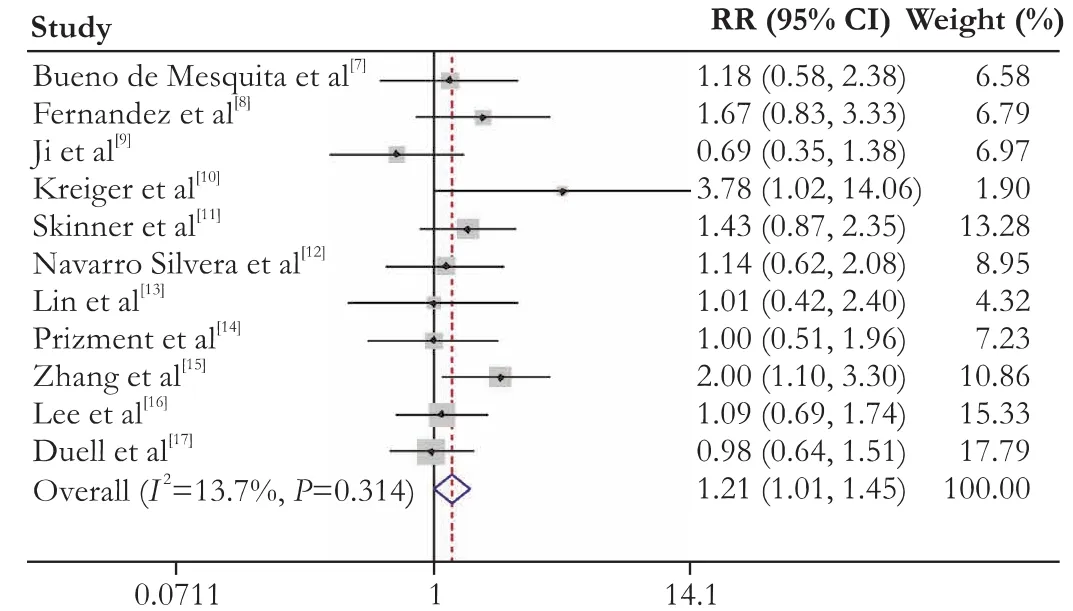
Fig.2.Forest plot:overall meta-analysis of age at first birth(highest versus lowest)and pancreatic cancer risk.Squares indicated study-specific risk estimates(size of square reflects the study-statistical weight,i.e.inverse of variance);horizontal lines indicate 95% CIs;diamond indicates pooled RR estimate with its corresponding 95% CI.
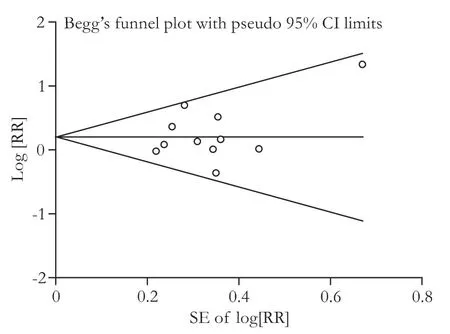
Fig.3.Funnel plot for publication bias in the studies investigating risk for pancreatic cancer associated with age at first birth.
In the present meta-analysis,there was no indication of publication bias with Egger’s test(P=0.383)or with Begg’s test(P=0.436),and no asymmetry was seen in the funnel plots when inspected visually(Fig.3).
In the sensitivity analysis,a single study was excluded at one time to investigate how individual study influenced the overall results.Sensitivity analysis showed that the effect of highest vs lowest categories of age at first birth on pancreatic cancer risk was robust(Fig.4).The pooled RRs of highest vs lowest categories of age at first birth ranged from a low value of 1.14(95% CI:0.94-1.38,P=0.537,I2=0)after exclusion of the study by Zhang et al[15]to a high value of 1.27(95% CI:1.04-1.54,P=0.314,I2=14.0%)after exclusion of the study by Duell et al.[17]
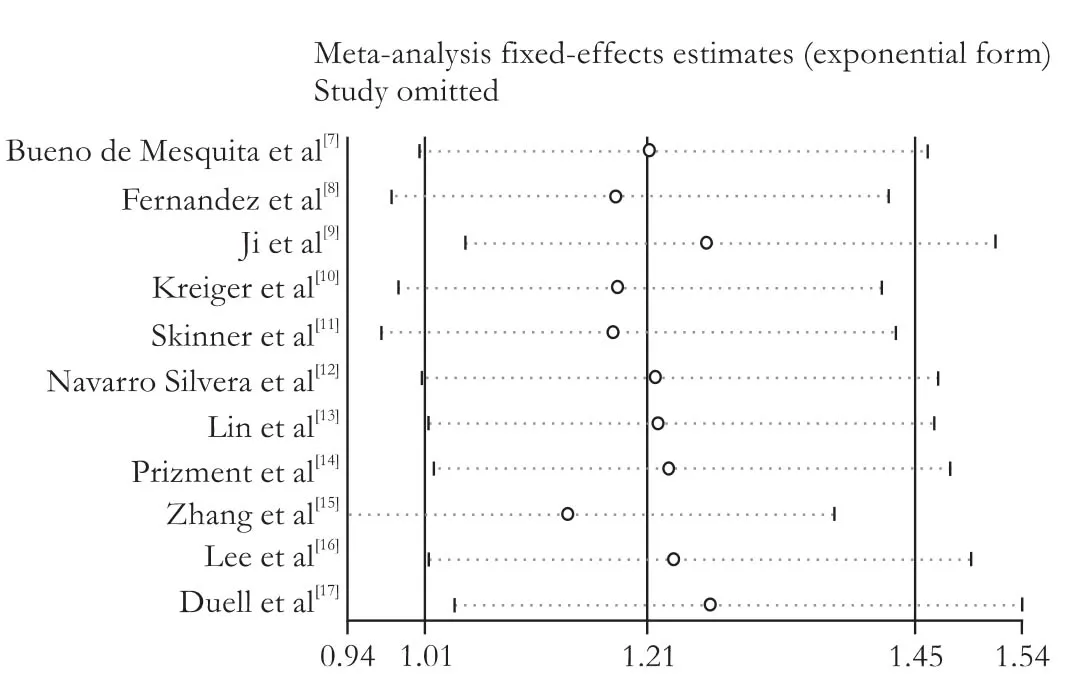
Fig.4.Sensitivity analyses for highest vs lowest categories of age at first birth.
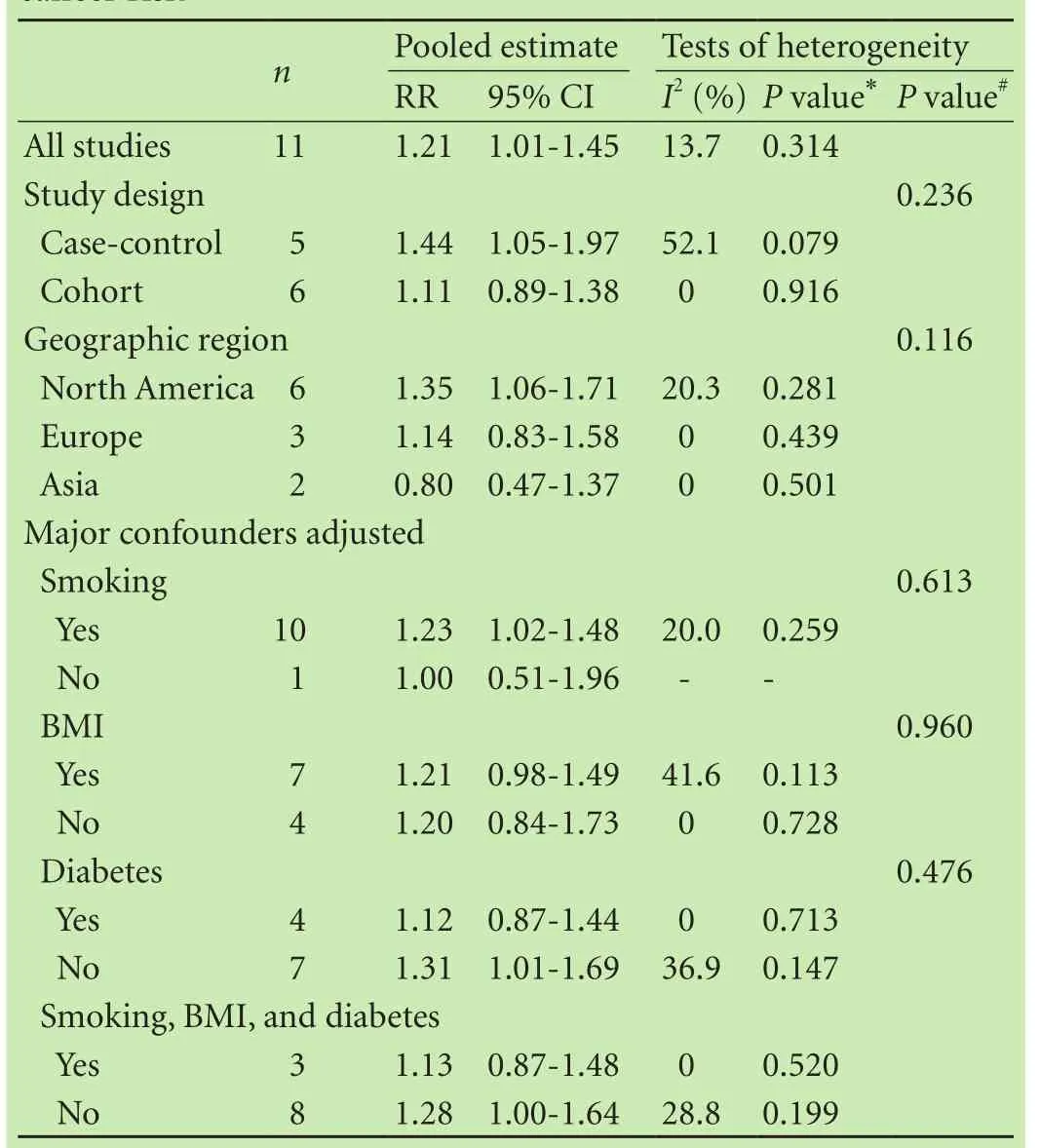
Table 2.Subgroup analyses of age at first birth and pancreatic cancer risk
Subgroup analyses
Meta-regression analyses did not show a significant heterogeneity between subgroups.Subgroup analyses in case-control studies demonstrated an increased risk of older age at first birth for pancreatic cancer(RR=1.44,95% CI:1.05-1.97,P=0.079,I2=52.1%).The geographic analysis showed that the risk was higher in North America(RR=1.35,95% CI:1.06-1.71,P=0.281,I2=20.3%)followed by Europe.In the subgroup analyses stratified by whether the study included adjustment for specific potential confounders or important risk factors,almost all strata,including smoking,BMI,diabetes,or all of the potential confounders showed positive associations ofage at first birth with pancreatic cancer risk,although not all of them showed statistical significance(Table 2).
Discussion
This is the first meta-analysis which provides quantitative and comprehensive evidences of the association between age at first birth and pancreatic cancer risk.We found that older age at first birth significantly increased the risk of pancreatic cancer.In the present meta-analysis,significant heterogeneity and publication bias were not detected among all studies.In addition,almost all strata showed positive associations of age at first birth with pancreatic cancer risk in our subgroup analyses,although not all of them showed statistical significance.Furthermore,when we examined whether the associations were affected by adjustment for smoking,BMI,diabetes,and all of the confounders or important risk factors,the associations were significantly affected by these factors except for BMI,indicating that the effect of those adjusted confounders on the results was great.Moreover,older age,male or Africa American,cigarette smoking,family history of pancreatic cancer,diabetes,and chronic pancreatitis have been identified as risk factors to some extent.[31]However,some included observational studies haven’t adjusted for these risk factors,so researchers should adjust these risk factors in the future.
Older age at first birth affects the balance of female hormones,like estrogen,which is prolonged because of the late childbirth time.Although our finding supports the hypothesis that pancreatic cancer is,at least in part,an estrogen-dependent disease,it is contrary to the proposed hypothesis that estrogen may reduce the risk of pancreatic cancer in women.[32]In fact,biological mechanisms that estrogen exposure acts on the risk of pancreatic cancer are unclear.Rodent models have shown that estradiol can inhibit the growth of preneoplastic pancreatic lesions or transplanted pancreatic carcinoma.[33-35]However,several sex-steroid biosynthetic enzymes(e.g.,pancreatic homogenates and aromatase)[36]and high levels of estrogen receptor proteins[37]have been detected in pancreatic cancer tissue,suggesting that estrogen may contribute to the development of pancreatic cancer.In addition,two small-scale case-control studies[38,39]found that the level of serum estrogen was higher in pancreatic cancer cases than that in age-matched controls.Furthermore,experimental and human studies have indicated that tamoxifen,a competitive inhibitor of estrogens on estrogen receptors,has an inhibitory effect on the early stages of pancreatic carcinogenesis.As a matter of fact,the dispute on whether estrogen increases or decreases pancreatic cancer risk in women is somewhat similar to that on breast cancer in women for many years.[40]
Our present meta-analysis has several advantages.First,we included six cohorts and five case-control studies,including 756560 controls and 2535 pancreatic cancer cases,which provided sufficient statistical power to detect this putative association.Second,we adopted the model adjusting for most established risk factors so that it could largely control the confounders.Third,due to the tendency of not publishing small studies with null results,no publication biases were detected,suggesting that the data were conclusive.
Despite these strengths,some potential limitations must be taken into consideration.First,as a meta-analysis,although cohort studies were less susceptible to bias due to their nature compared with case-control studies,the possibility of recall and selection biases was inherent.Second,there was a relatively wide range of values for taking the highest category of age at first birth as cutoff point,so we could not assign an exposure value to openended category accurately,which might influence our present analysis.Third,there is some controversy over the quality scoring which lacks validity in a meta-analysis,the results may be irrelevant to quality.[41]We did not use the Newcastle-Ottawa Scale to evaluate the methodological quality of involved studies,instead of carrying out multiple subgroup and sensitivity analyses.Finally,because we did not have access to the primary data of the studies,we could not perform additional adjustments for potentially important covariates.
In conclusion,the current meta-analysis suggests that older age at first birth significantly increases the risk of pancreatic cancer in women.Well-controlled confounding factors are warranted to further elucidate their association,and the exact functional mechanism needs further investigation.
Contributors:LAJ and FRH proposed the study and wrote the first draft.FRH,WXW and WFZ collected and analyzed the data.All authors contributed to the design and interpretation of the study and to further drafts.FRH is the guarantor.
Funding:None.
Ethical approval:Not needed.
Competing interest:No benefits in any form have been received or will be received from a commercial party related directly or indirectly to the subject of this article.
References
1 Siegel R,Ward E,Brawley O,Jemal A.Cancer statistics,2011:the impact of eliminating socioeconomic and racial disparities on premature cancer deaths.CA Cancer J Clin 2011;61:212-236.
2 Wolfgang CL,Herman JM,Laheru DA,Klein AP,Erdek MA,Fishman EK,et al.Recent progress in pancreatic cancer.CA Cancer J Clin 2013;63:318-348.
3 Zou L,Zhong R,Shen N,Chen W,Zhu B,Ke J,et al.Nonlinear dose-response relationship between cigarette smokingand pancreatic cancer risk:evidence from a meta-analysis of 42 observational studies.Eur J Cancer 2014;50:193-203.
4 Raimondi S,Maisonneuve P,Lowenfels AB.Epidemiology of pancreatic cancer:an overview.Nat Rev Gastroenterol Hepatol 2009;6:699-708.
5 Lowenfels AB,Maisonneuve P.Epidemiology and risk factors for pancreatic cancer.Best Pract Res Clin Gastroenterol 2006;20:197-209.
6 Bourhis J,Lacaine F,Augusti M,Huguier M.Protective effect of oestrogen in pancreatic cancer.Lancet 1987;2:977.
7 Bueno de Mesquita HB,Maisonneuve P,Moerman CJ,Walker AM.Anthropometric and reproductive variables and exocrine carcinoma of the pancreas:a population-based case-control study in The Netherlands.Int J Cancer 1992;52:24-29.
8 Fernandez E,La Vecchia C,D’Avanzo B,Negri E.Menstrual and reproductive factors and pancreatic cancer risk in women.Int J Cancer 1995;62:11-14.
9 Ji BT,Hatch MC,Chow WH,McLaughlin JK,Dai Q,Howe GR,et al.Anthropometric and reproductive factors and the risk of pancreatic cancer:a case-control study in Shanghai,China.Int J Cancer 1996;66:432-437.
10 Kreiger N,Lacroix J,Sloan M.Hormonal factors and pancreatic cancer in women.Ann Epidemiol 2001;11:563-567.
11 Skinner HG,Michaud DS,Colditz GA,Giovannucci EL,Stampfer MJ,Willett WC,et al.Parity,reproductive factors,and the risk of pancreatic cancer in women.Cancer Epidemiol Biomarkers Prev 2003;12:433-438.
12 Navarro Silvera SA,Miller AB,Rohan TE.Hormonal and reproductive factors and pancreatic cancer risk:a prospective cohort study.Pancreas 2005;30:369-374.
13 Lin Y,Kikuchi S,Tamakoshi A,Kawamura T,Inaba Y,Kurosawa M,et al.Association of menstrual and reproductive factors with pancreatic cancer risk in women:findings of the Japan Collaborative Cohort Study for Evaluation of Cancer Risk.J Gastroenterol 2006;41:878-883.
14 Prizment AE,Anderson KE,Hong CP,Folsom AR.Pancreatic cancer incidence in relation to female reproductive factors:Iowa Women’s Health Study.JOP 2007;8:16-27.
15 Zhang Y,Coogan PF,Palmer JR,Strom BL,Rosenberg L.A casecontrol study of reproductive factors,female hormone use,and risk of pancreatic cancer.Cancer Causes Control 2010;21:473-478.
16 Lee E,Horn-Ross PL,Rull RP,Neuhausen SL,Anton-Culver H,Ursin G,et al.Reproductive factors,exogenous hormones,and pancreatic cancer risk in the CTS.Am J Epidemiol 2013;178:1403-1413.
17 Duell EJ,Travier N,Lujan-Barroso L,Dossus L,Boutron-Ruault MC,Clavel-Chapelon F,et al.Menstrual and reproductive factors in women,genetic variation in CYP17A1,and pancreatic cancer risk in the European prospective investigation into cancer and nutrition(EPIC)cohort.Int J Cancer 2013;132:2164-2175.
18 Duell EJ,Holly EA.Reproductive and menstrual risk factors for pancreatic cancer:a population-based study of San Francisco Bay Area women.Am J Epidemiol 2005;161:741-747.
19 Teras LR,Patel AV,Rodriguez C,Thun MJ,Calle EE.Parity,other reproductive factors,and risk of pancreatic cancer mortality in a large cohort of U.S.women(United States).Cancer Causes Control 2005;16:1035-1040.
20 Heuch I,Jacobsen BK,Albrektsen G,Kv?le G.Reproductive factors and pancreatic cancer risk:a Norwegian cohort study.Br J Cancer 2008;98:189-193.
21 Lucenteforte E,Zucchetto A,Bosetti C,Talamini R,Negri E,Serraino D,et al.Reproductive and hormonal factors and pancreatic cancer risk in women.Pancreas 2011;40:460-463.
22 Moher D,Liberati A,Tetzlaff J,Altman DG;PRISMA Group.Preferred reporting items for systematic reviews and meta-analyses:the PRISMA statement.Ann Intern Med 2009;151:264-269.
23 Stroup DF,Berlin JA,Morton SC,Olkin I,Williamson GD,Rennie D,et al.Meta-analysis of observational studies in epidemiology:a proposal for reporting.Meta-analysis Of Observational Studies in Epidemiology(MOOSE)group.JAMA 2000;283:2008-2012.
24 Greenland S.Quantitative methods in the review of epidemiologic literature.Epidemiol Rev 1987;9:1-30.
25 Hamling J,Lee P,Weitkunat R,Ambühl M.Facilitating metaanalyses by deriving relative effect and precision estimates for alternative comparisons from a set of estimates presented by exposure level or disease category.Stat Med 2008;27:954-970.
26 DerSimonian R,Laird N.Meta-analysis in clinical trials.Control Clin Trials 1986;7:177-188.
27 Higgins JP,Thompson SG,Deeks JJ,Altman DG.Measuring inconsistency in meta-analyses.BMJ 2003;327:557-560.
28 Higgins JP,Thompson SG.Quantifying heterogeneity in a meta-analysis.Stat Med 2002;21:1539-1558.
29 Egger M,Davey Smith G,Schneider M,Minder C.Bias in metaanalysis detected by a simple,graphical test.BMJ 1997;315:629-634.
30 Begg CB,Mazumdar M.Operating characteristics of a rank correlation test for publication bias.Biometrics 1994;50:1088-1101.31 Michaud DS.Epidemiology of pancreatic cancer.Minerva Chir 2004;59:99-111.
32 Benz C,Hollander C,Miller B.Endocrine-responsive pancreatic carcinoma:steroid binding and cytotoxicity studies in human tumor cell lines.Cancer Res 1986;46:2276-2281.
33 Longnecker DS,Sumi C.Effects of sex steroid hormones on pancreatic cancer in the rat.Int J Pancreatol 1990;7:159-165.
34 Sumi C,Longnecker DS,Roebuck BD,Brinck-Johnsen T.Inhibitory effects of estrogen and castration on the early stage of pancreatic carcinogenesis in Fischer rats treated with azaserine.Cancer Res 1989;49:2332-2336.
35 Sumi C,Brinck-Johnsen T,Longnecker DS.Inhibition of a transplantable pancreatic carcinoma by castration and estradiol administration in rats.Cancer Res 1989;49:6687-6692.
36 Iqbal MJ,Greenway B,Wilkinson ML,Johnson PJ,Williams R.Sex-steroid enzymes,aromatase and 5 alpha-reductase in the pancreas:a comparison of normal adult,foetal and malignant tissue.Clin Sci(Lond)1983;65:71-75.
37 Greenway B,Iqbal MJ,Johnson PJ,Williams R.Oestrogen receptor proteins in malignant and fetal pancreas.Br Med J(Clin Res Ed)1981;283:751-753.
38 Fyssas I,Syrigos KN,Konstandoulakis MM,Papadopoulos S,Milingos N,Anapliotou M,et al.Sex hormone levels in the serum of patients with pancreatic adenocarcinoma.Horm Metab Res 1997;29:115-118.
39 Corbishley TP,Iqbal MJ,Wilkinson ML,Williams R.Circulating sex steroids and sex hormone binding globulin in pancreatic adenocarcinoma.Anticancer Res 1986;6:219-222.
40 Kelsey JL,Gammon MD,John EM.Reproductive factors and breast cancer.Epidemiol Rev 1993;15:36-47.
41 Greenland S.Invited commentary:a critical look at some popular meta-analytic methods.Am J Epidemiol 1994;140:290-296.
Received May 14,2015
Accepted after revision November 10,2015
doi:10.1016/S1499-3872(16)60063-2
Corresponding Author:Rui-Hua Feng,PhD,Center for Health Policy and Management,China Academy of Medicine Sciences,Yabao Road No.3,Chaoyang District,Beijing 100020,China(Tel:+86-10-52328852;Email:fengruihua421@hotmail.com)
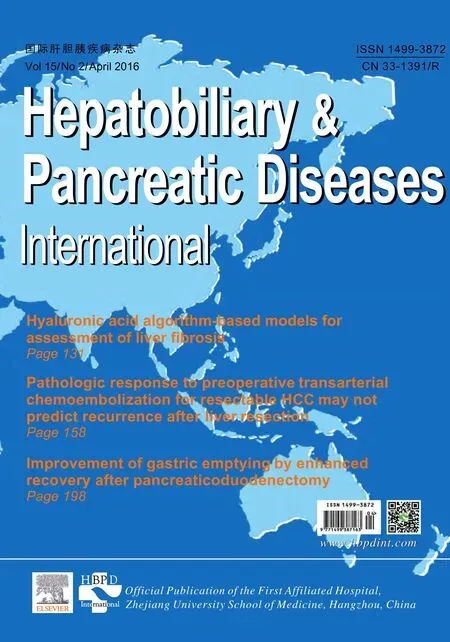 Hepatobiliary & Pancreatic Diseases International2016年2期
Hepatobiliary & Pancreatic Diseases International2016年2期
- Hepatobiliary & Pancreatic Diseases International的其它文章
- Pathologic response to preoperative transarterial chemoembolization for resectable hepatocellular carcinoma may not predict recurrence after liver resection
- Role of microRNA in liver regeneration
- An unusual case of prolonged post-endoscopic retrograde cholangiopancreatography jaundice
- Surgical treatment of synchronous colorectal liver and lung metastases:the usefulness of thoracophrenolaparotomy for single stage resection
- Monocyte chemoattractant protein-1,transforming growth factor-β1,nerve growth factor,resistin and hyaluronic acid as serum markers:comparison between recurrent acute and chronic pancreatitis
- Improvement of gastric emptying by enhanced recovery after pancreaticoduodenectomy
